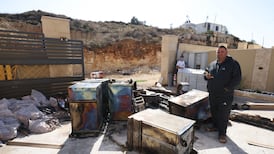Many besieged Syrian towns and cities are on the brink of falling to government forces, leading to mass evacuations similar to those seen in the town of Daraya last week, the UN predicted on Thursday.
The UN blamed an intensification of the conflict and the Syrian government’s refusal to allow aid agencies into the besieged towns with food and medicine.
Residents of Daraya, one of the hubs of resistance to the rule of Bashar al-Assad, the Syrian president, endured a four-year siege in the city but last month thousands of civilians were evacuated. As many as 4,000 civilians and 700 fighters left the town, which is 32km from the capital, Damascus.
Speaking in Geneva, Staffan de Mistura, the UN special envoy for Syria, said he feared that "after Daraya we may have other Darayas – that is a strategy taking place". He warned that if the numbers in Daraya were a shock, other towns could be involved in much larger-scale evacuations involving tens of thousands of residents.
Jan Egeland, co-ordinator of the Geneva based UN humanitarian task force in Syria, concurred with Mr de Mistura, saying: "There [are] now urgent pleas in al-Waer, Madaya, Moadamiya, Foua and Kufrey. They all fear for their future and we need to break these sieges."
In Madaya, a menginitis epidemic had broken out, he warned, describing the situation as “becoming unbearable”. He said he was heartbroken over Daraya.
“The task force failed the people of Daraya. We all failed. I feel I failed them. It is really sad to think of what they went through over these years. A siege is not broken by giving up after bombing and starvation. It is lifted by humanitarian access and freedom of movement in an and out by the civilian population. There is, at the moment, a militarisation of the conflict and we are being routinely blocked.”
Mr Egeland said that Daraya had surrendered following the UN's weekly pleas to the Syrian government to allow aid into the starving town – pleas which had been spurned. The residents of Daraya had now fled to Damascus, Idlib and Madaya, which was also besieged.
He added that discussions were still going on to reach agreement on a 48-hour ceasefire in east Aleppo that would include an agreed access road. He said: "There are 4,000 food rations left, enough for 20,000 people – and the population is 250,000."
Mr Egeland said certain groups in the UN humanitarian task force had previously signalled that they had influence on the ground yet evidence had indicated that that power had diminished in recent weeks.
During the entire month of August, UN aid had reached only three of the 18 besieged areas, which represented less than a third of the population in such spots. He said a UN request to the Syrian government to reach 1.2 million people in September had not even received an answer despite the largest humanitarian operation worldwide being available.
Mr de Mistura insisted that emptying and destroying towns represented a pyrrhic victory, and a political solution was still needed.
Discussions at senior military and diplomatic levels between US and Russia on a wider ceasefire were likely to continue until Saturday morning, he said. The conclusion of these talks – which are being overseen by the Russian foreign minister, Sergei Lavrov, and the US secretary of state, John Kerry – would then probably be passed to Barack Obama and Vladimir Putin at the G20 summit in China ahead of the UN general assembly in New York, which begins on September 19th.
Ahead of the assembly, the Friends of Syria ministerial group will meet in London and talk to leaders of the Syrian opposition to discuss a strategy for political transition.
Guardian service
















